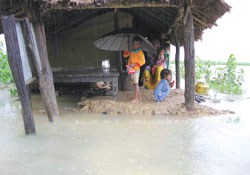
India and Nepal try to break the ice on joint hyrdopower
Sep 8, 2006 - Kunda Dixit - Nepali
Times
 |
| MAROONED: A family in Holiya
VDC in Banke sits out floods that swept the region
on 25 August. Tens of thousands are still waiting
for relief. (RAMESWOR BOHARA) |
There is a 20 percent shortfall in
power supply on the north Indian grid this summer
Parts of New Delhi are suffering six-hour power
cuts daily
Nepal sits on anywhere between 45,000-80,000 MW
There is demand, and there is supply, yet
Nepal and India can’t agree on sharing power and water
for mutual benefit. Joint river projects are a political
hot potato in Nepal because of the perception that
India took advantage of past schemes. After 1990,
there were efforts to start multipurpose projects
like Mahakali and Tanakpur, but those are also stalled.
Now, the private sectors in India and Nepal are trying
to see if they can succeed where their governments
failed. The Independent Power Producers’ Association
of Nepal (IPPAN) and the Power Trading Corporation
(PTC) of India are holding a ‘Power Summit’ in Kathmandu
this week to fast-track joint hydropower projects.
“We need to treat hydropower as a commodity, not just
for export but also for our own growing domestic use,”
says IPPAN’s Sandip Shah, “This conference is a good
start. We have to delink power from geopolitics and
governments must leave the business of business to
business.” In order to stay away from politics, investors
on both sides are showing pragmatism by talking just
electricity and keeping multipurpose projects out
of the equation for now. “We want to discuss energy
and leave it to market forces,” says the PTC’s chairman
Tantra Thakur, “there are complementarities we could
use for mutual benefit.” Over 30 top Indian investors,
bankers and technocrats are attending the two-day
conference. Nepal’s proximity to load centres in northern
India is seen as ideal. Nepal also generates surplus
hydropower during the monsoon when demand in India
is highest, and India’s thermal plants generate a
surplus when Nepal has a winter shortage. An immediate
priority is to connect the two grids so more power
can be traded. Nepal has asked India for 100MW to
meet this year’s winter shortfall in exchange for
which Nepal will provide spill energy to India next
monsoon. But this won’t be possible until cross-border
transmission lines are in place. “We will consider
positively Nepal’s request for supply of electricity
on commercial terms during the coming winter,” Indian
ambassador Shiv Shanker Mukherjee told the conference,
“although India has its own power shortage.” In the
medium-term, the conference will look into political
risk for investors in Nepal, which has been a stumbling
block for the only other export project currently
planned, the 750MW West Seti. Although one Indian
investor felt “political risk in Nepal is not as serious
as it is made out to be”, it is a concern for offshore
investors.

|